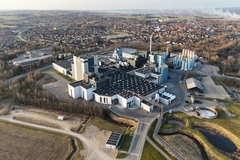
- Industry news
Industry news
- Category news
Category news
- Reports
- Key trends
- Multimedia
Multimedia
- Journal
- Events
- Suppliers
- Home
- Industry news
Industry news
- Category news
Category news
- Reports
- Key trends
- Multimedia
Multimedia
- Events
- Suppliers
Kraft Optimistic on Turnaround Plan

For the full year, the company projects organic net revenue growth of at least 6 percent and earnings per share, excluding items, of at least $1.88, reflecting an impact of ($0.04) from exiting the Post cereals business.
04/09/08 Kraft Foods Inc. has provided investors with an optimistic review of the company's progress at the midpoint of its three-year turnaround plan, at the Lehman Brothers Back-to-School Consumer Conference. In particular, the company outlined advances at Kraft International, currently a $16 billion business and a key driver of Kraft's growth plans. Management also updated financial guidance for 2008, reflecting the recent split-off of the Post cereals business, and provided initial 2009 guidance.

"At the midpoint of our three-year turnaround, we're successfully rebuilding our brands through investments in quality, innovation and marketing across our global portfolio," said Irene Rosenfeld, Chairman and Chief Executive Officer. "We've rejuvenated some of our biggest businesses and created new incremental platforms that we can leverage across brands and categories. As a result, our brands are more relevant to consumers, who are seeking value during tough times. Rebuilding our brands combined with improved execution at retail have been key to driving solid volume and mix growth despite significant cost-driven price increases."
Rosenfeld continued, "Most importantly, we're delivering improved financial results. As our portfolio has improved and our momentum builds, we are returning Kraft to reliable, long-term growth. I'm confident we'll hit our stride in 2009 and deliver earnings of at least $2.00 per share."
Following Rosenfeld, Sanjay Khosla, Executive Vice President and President, Kraft International, outlined the pillars of the company's international growth strategy, including greater focus on core categories, brands and geographies. "Instead of planting Kraft flags all over the world and trying to be all things to all people, we are now focusing where we can win," Khosla said.
Specifically, Kraft International is concentrating on:
• Five categories: Biscuits, Chocolate, Powdered Beverages, Coffee and Cream Cheese.
• 10 brands: Oreo cookies; Tuc/Club Social crackers; Jacobs and Carte Noire coffees; Milka, Cote d'Or, Toblerone and Lacta chocolates; Philadelphia cream cheese; and Tang powdered beverages.
• 10 markets: Four growth engines, including China, Russia, Brazil and Southeast Asia, and six scale markets, including Germany, France, United Kingdom, Italy, Spain and Australia.
"All of this adds up to a powerful growth engine for Kraft," said Khosla. "Early results show our strategy is working, as we have significantly accelerated both top- and bottom-line growth. In addition, we have improved the depth of our international management team, so I believe the best is yet to come."
In the first half of 2008, Kraft International's organic revenue growth was 11.7 percent. That's up from 6.8 percent for 2007 and up from a 2.4 percent compounded annual growth rate (CAGR) from 2003 to 2006. Operating income growth(1) at Kraft International grew by 15 percent in the first six months of 2008, compared to 3 percent growth in 2007 and a negative CAGR of (3.5) percent from 2003 to 2006.
Tim McLevish, Executive Vice President and Chief Financial Officer, concluded with an update on Kraft's financial turnaround. "Our underlying premise is that we will use a combination of price increases and supply chain productivity improvements to cover input cost inflation while our volume growth and product mix gains will leverage our overhead costs and increase operating margins," he said.
Using this model, the company affirmed its long-term EPS growth of 7 to 9 percent. This includes at least 4 percent of organic revenue growth, two to three points of leverage from manufacturing and overhead costs and one to two points of benefit from cash flow leverage and lower taxes.
"We have found ways to optimize some of the initiatives under our existing restructuring program," McLevish said. "This will lead to annualized savings of $1.4 billion, which is $200 million greater than previously expected." Kraft expects to reach approximately $1.1 billion in savings by year-end 2008. Spending on the program will be approximately $900 million in 2008, for a total of $3 billion.
"As our new structure takes hold, we will deliver additional overhead savings as we target best-in-class benchmarks and practices across each of our support functions," he said. "As a result, we intend to reduce overhead costs as a percent of revenue by at least 100 basis points over the next few years." As the company transitions from its current restructuring program to a "pay-as-you-go" model in 2009, the annual cash used for cost-savings initiatives is expected to decline by approximately $300 million a year versus 2008 levels over time.
McLevish also updated Kraft's 2008 guidance. For the full year, the company projects organic net revenue growth of at least 6 percent and earnings per share, excluding items, of at least $1.88, reflecting an impact of ($0.04) from exiting the Post cereals business. In addition, Kraft's full-year effective tax rate is now expected to be 33 percent, as the largely U.S. Post cereals business is moved to discontinued operations.
In 2009, the company is targeting organic net revenue growth of at least 4 percent and earnings per share of at least $2.00 on a GAAP basis. "This reflects double-digit growth from continuing operations and is higher than our 7-9 percent long-term target on an apples-to-apples basis," McLevish said.
McLevish also reiterated targets for improvements in several financial metrics over the next few years. Specifically,
• Improve annual discretionary cash flow by $1 billion.
• Reduce primary working capital to 11 percent of net revenue, from 14 percent at year-end 2007.
• Reduce capital spending to less than 3 percent of net revenues. Adjusting for the Post transaction, capital spending was approximately 3.4 percent of net revenues in 2007.










